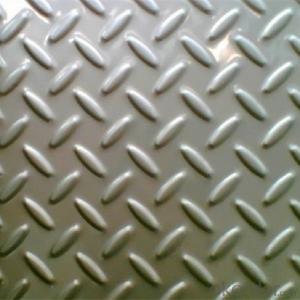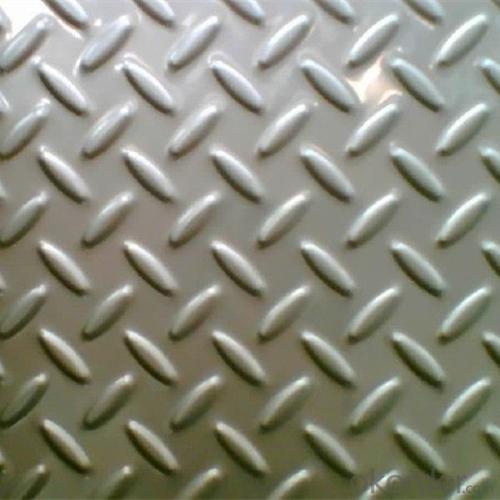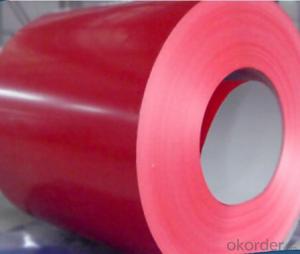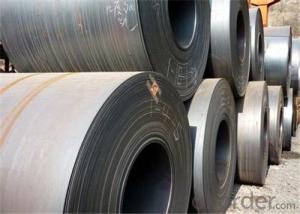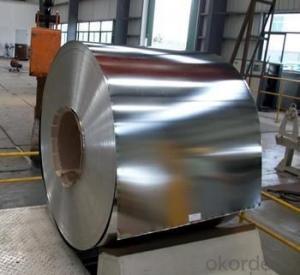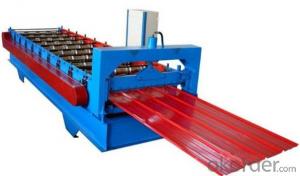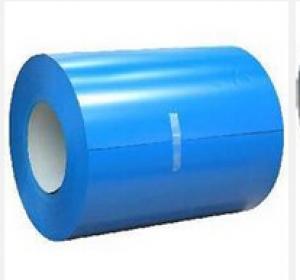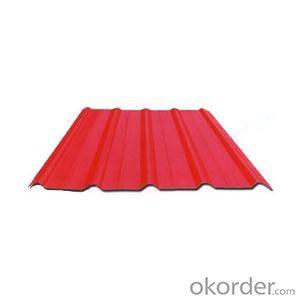Prime Hot Rolled HR Steel Chequered Sheets
- Loading Port:
- China main port
- Payment Terms:
- TT OR LC
- Min Order Qty:
- 23 m.t.
- Supply Capability:
- 10000 m.t./month
OKorder Service Pledge
OKorder Financial Service
You Might Also Like
Specification

Commodity | Checkered plate/sheet |
Thickness | 1.8mm-15mm as customer's requirement |
Width | 1000mm,1220mm,1250mm,1500mm |
Length | 2440mm,6m,8-12m, as customer’s requirement |
Standard & steel grade | ASTM A36 EN10025 S235JR;S355JR JIS G 3101 SS400;SS490;SS540 DIN 17100 ST 37-2 GB/T 700 Q235; Q345 |
Surface | Smooth, straight |
Packing | diamond (teardrop type), lentils form, round beans form |
Application | Be strapped with Iron packing belts, Standard exporting packing |

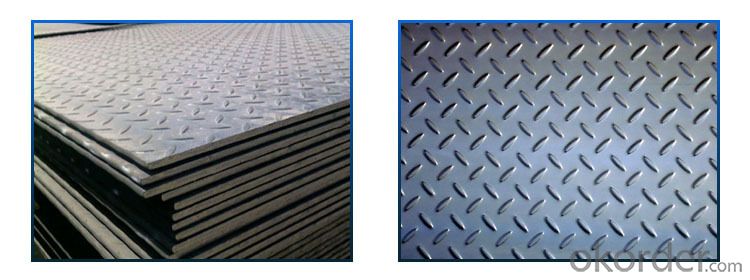

Standard | Grade | Chemical Compostiton(%) | |||||
C | Mn | Si | S | P | |||
≤ | |||||||
Q235 | A | 0.14~0.22 | 0.30~0.65 | 0.05 | 0.045 | ||
B | 0.12~0.20 | 0.30~0.70 | 0.3 | 0.045 | |||
C | ≤0.18 | 0.35~0.80 | 0.04 | 0.04 | |||
D | ≤0.17 | 0.035 | 0.035 | ||||
Mechanical Properties | |||||||
Standard | Tensile Strength(MPa) | Yield Point | Elongation(%) | ||||
Q235 | 375~500 | 235 | 26 | ||||
Q345B Chemical Composition(%) | ||||
C | Mn | Si | S | P |
≤0.20 | ≤1.70 | ≤0.50 | ≤0.035 | ≤0.035 |
Q345B Mechanical Properties | ||||
Tension Strength | Yield Point | Elongation | ||
470-630 | 345 | 21 | ||

Checkered steel plate beautiful shape, can prevent slippery, improved performance, save a lot of advantages, such as steel in transportation, construction, decoration, equipment around the base plate, machinery, shipbuilding and other fields have a wide range of applications.
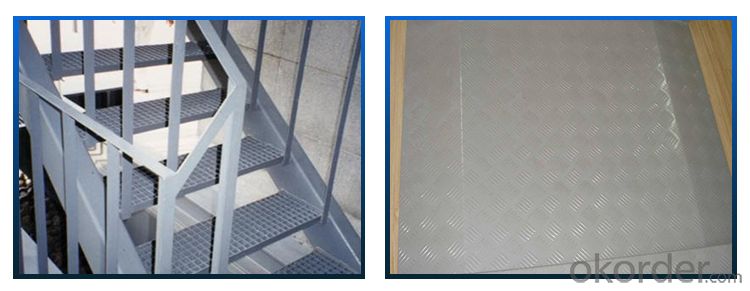
- Q: What are the different finishes available for steel coils?
- There are several different finishes available for steel coils, each offering its own unique set of characteristics and benefits. Some of the most common finishes include: 1. Hot-dip galvanized: This finish involves immersing the steel coil in a bath of molten zinc, which creates a protective layer that prevents corrosion and rust. It provides excellent durability and long-term protection against harsh environmental conditions. 2. Electro-galvanized: Similar to hot-dip galvanizing, this finish uses an electrical current to apply a thin layer of zinc onto the steel coil. It offers good corrosion resistance and aesthetics, making it suitable for various applications. 3. Galvannealed: This finish combines the benefits of galvanizing and annealing processes. The steel coil is first galvanized and then annealed, resulting in a matte grey appearance with enhanced paint adhesion. Galvannealed finishes are commonly used in automotive and appliance industries. 4. Pre-painted: Also known as coil coating, this finish involves applying a layer of paint onto the steel coil before it is formed into its final product. Pre-painted finishes offer a wide range of colors, textures, and gloss levels, allowing for customization and improved aesthetics. 5. Stainless steel: Steel coils can also be finished with a layer of stainless steel, which provides excellent resistance to corrosion, heat, and chemicals. Stainless steel finishes are often utilized in applications where hygiene, durability, and a high-quality appearance are essential, such as in the food and beverage industry. 6. Cold-rolled: This finish involves passing the steel coil through a series of rollers at room temperature, resulting in a smooth, polished surface. Cold-rolled finishes offer improved dimensional accuracy, surface quality, and flatness, making them suitable for applications that require tight tolerances and a refined appearance. 7. Metallic coated: This finish involves applying a layer of a metallic coating, such as aluminum or zinc-aluminum alloy, onto the steel coil. Metallic coated finishes offer excellent corrosion resistance, lightweight properties, and aesthetic versatility. Overall, the choice of finish for steel coils depends on the specific requirements of the application, considering factors such as corrosion resistance, aesthetics, durability, and cost-effectiveness. It is important to consult with industry experts and manufacturers to determine the most suitable finish for a particular project.
- Q: A song by brokencyde is called Blue Steel.... a verse in it says Don't make me show you blue steel.
- Blue okorder /
- Q: I would like to know if steel is basically a very dense crystal, or if it is a different atomic structure
- Steel is crystalline. In general the bigger the crystals the better.
- Q: and also what makes different hardness of stainless steel?
- The person above me is right .The stainless steel is used in shaving blades
- Q: What are the common coil diameter and weight combinations available for steel coils?
- The common coil diameter and weight combinations available for steel coils vary depending on the specific requirements of the industry or application. However, some commonly available coil diameter ranges include 24 inches to 72 inches, while weight combinations can range from 3,000 pounds to 50,000 pounds or more. These dimensions can be further customized based on the needs of the customer and the capabilities of the steel manufacturer.
- Q: What are the different methods of surface inspection for steel coils?
- Steel coils can undergo surface inspection using various methods, each with its advantages and limitations. Among the commonly used techniques are: 1. Visual Inspection: Inspectors visually examine the steel coil surface for defects like scratches, dents, or discoloration. Though subjective and reliant on inspector expertise, this method proves cost-effective for detecting obvious defects. 2. Magnetic Particle Inspection (MPI): This method involves applying a magnetic field to the coil and then iron particles on the surface. Disruptions in the magnetic field caused by defects or cracks gather the particles, making the flaws visible. MPI effectively detects surface cracks and defects not easily seen by the naked eye. 3. Eddy Current Testing (ECT): ECT, a non-destructive testing method, employs electromagnetic induction to identify surface defects in steel coils. A probe with a coil generates an alternating magnetic field near the coil surface. Changes in electrical conductivity or magnetic permeability due to surface defects lead to a change in the induced current, which can be analyzed. ECT successfully identifies cracks, corrosion, and other surface irregularities. 4. Ultrasonic Testing (UT): High-frequency sound waves are used to examine both the surface and subsurface of steel coils. A transducer sends ultrasonic waves into the steel, and the reflected waves are analyzed to detect material changes or anomalies. UT effectively identifies cracks, delaminations, or voids within the coil, providing valuable insights into the steel's structural integrity. 5. Optical Inspection: This technique utilizes advanced imaging techniques like cameras or laser scanners to capture high-resolution images of the coil surface. These images are then analyzed for defects such as scratches, pits, or irregularities. Optical inspection provides detailed information and is often used alongside other methods for a comprehensive inspection. It is important to note that each method has its limitations and may be more suitable for specific defect types or surface conditions. Therefore, a combination of these techniques is often employed to ensure a thorough and accurate inspection of steel coils.
- Q: i want to know if i should buy a set of acrylic tapers or steel. they r close in cost so it's not a money factor i want to know which work better and if there is a downside to either. thanks!
- It relies upon on your physique and what you desire. in case you physique is allergic to a minimum of one in all them you may would desire to chosen for yet another one. If this is not any longer allergic to any, than you need to use in spite of you like the main, in simple terms attempt the two.
- Q: How are steel coils used in the production of wind turbines?
- Steel coils are used in the production of wind turbines to manufacture the tower, nacelle, and other structural components. The coils are processed and shaped into various parts, ensuring the turbines have a sturdy and durable construction. Additionally, steel coils are employed in the manufacturing of the turbine blades, providing strength and reliability to withstand the forces of wind.
- Q: How are steel coils used in the production of structural components?
- Steel coils are an integral part of the production process for structural components. These coils, which are made of steel that has been rolled into a continuous strip, provide the raw material necessary for manufacturing a variety of structural components, such as beams, columns, and trusses. The first step in using steel coils for structural components involves uncoiling the strip and cutting it into the desired lengths. This can be done using a variety of cutting methods, such as shearing or sawing. Once the coils are cut into lengths, they are then processed further to shape them into the specific structural components needed for a particular project. One common method used to shape steel coils into structural components is through the process of bending or forming. This involves using specialized machinery to bend or shape the steel into the desired configuration. For example, a steel coil can be bent into an I-beam shape, which is commonly used as a load-bearing structural component in buildings and bridges. Another method used to shape steel coils into structural components is through the process of welding. This involves joining multiple steel coils together to create a larger component. Welding is often used to fabricate components such as columns or trusses, which require the combination of multiple steel coils to achieve the necessary strength and structural integrity. Once the steel coils have been shaped and formed into the desired structural components, they may undergo additional processes, such as surface treatment or coating, to enhance their durability and resistance to corrosion. This ensures that the components will have a long lifespan and can withstand the demands of their intended applications. In summary, steel coils are essential in the production of structural components as they provide the raw material necessary for manufacturing. Through processes such as cutting, bending, and welding, steel coils are shaped into the specific components needed for various construction projects. These components play a crucial role in supporting the structural integrity of buildings, bridges, and other structures.
- Q: How are steel coils used in the production of steel chains?
- Steel coils are used in the production of steel chains by being unwound and fed into a machine that shapes and forms the individual links of the chain. The steel coils provide the raw material needed to create the strong and durable chains, ensuring they have the necessary strength and integrity for various applications.
Send your message to us
Prime Hot Rolled HR Steel Chequered Sheets
- Loading Port:
- China main port
- Payment Terms:
- TT OR LC
- Min Order Qty:
- 23 m.t.
- Supply Capability:
- 10000 m.t./month
OKorder Service Pledge
OKorder Financial Service
Similar products
Hot products
Hot Searches
Related keywords
